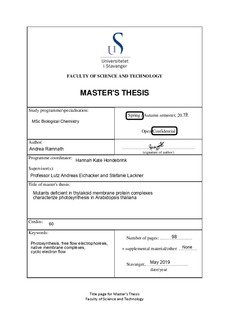| dc.description.abstract | Photosynthesis involves two major pathways through which light energy can be harvested and transformed into chemical energy. Light drives the flow of electrons through a chain of redox protein complexes to synthesize NADPH and is coupled to a flow of protons and ions across the thylakoid membrane of chloroplasts that drives ATP synthesis. The first route, namely linear electron flow begins at the reaction centre of Photosystem II (termed P680), couples to proton flow and the synthesis of ATP at the Cytochrome b6f complex and ends at the reaction centre of Photosystem I (termed P700), where the terminal electron acceptor NADP+ is reduced to NADPH. NADPH levels can consequently give us a comparative indication of how much linear electron flow is occurring. The second route, namely cyclic electron flow begins and ends at Photosystem I. Here, proton flow is also generated at the Cytochrome b6f complex and ATP is synthesized. However, no accumulation of NADPH can occur since electrons are recycled from reduced ferredoxin from the acceptor side of Photosystem I. Alternatively, NADPH present inside the chloroplast can be used to reduce plastoquinone, the substrate of Cytochrome b6f. Cyclic electron flow is believed to contribute to a regulation of photosynthesis and photoprotection in Arabidopsis thaliana. However, the components’ importance and regulation is unclear. Two main partially redundant pathways are known, through which electrons are recycled back to plastoquinone: First, the “Proton Gradient Regulation 5” (PGR5) and “PGR5-Like Photosynthetic Phenotype 1” (PGRL1) and second, the “Chloroplast NADH dehydrogenase-like” (NDH) complex dependent pathways.
Here, photosystem complexes were isolated from the stroma thylakoid membrane of mutants crr2 and pgr5 in A. thaliana. Protein complexes were separated by free-flow interval zone electrophoresis, and analysed by spectroscopy, native-PAGE, dynamic light scattering and zeta potential measurements. Also, protein subunit composition was analysed by mass spectrometry. Further analysis of complex composition was done using SDS-PAGE and Western blotting. An indication towards a determination of the mode of electron transport was made using absorbance spectroscopy. It was shown that Photosystem I and Cytochrome b6f complexes were found in complex together, and that this is a key complex in photosynthesis. Furthermore, it was shown that the absence of the PGR5 protein or NDH complex did not affect complex formation in the thylakoid stroma lamellae. Though, it could be shown that the ratio of complexes in the thylakoid stroma lamellae changed between the mutants and the wild-type. In addition, spectroscopic analysis of selected complexes suggested that the nature of PSI complexes was altered. Moreover, an increase in NADPH absorbance under light incubation suggested that both mutants show differences in linear electron flow rates. | nb_NO |

